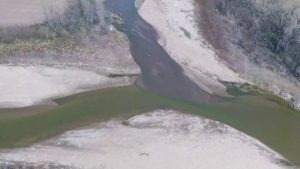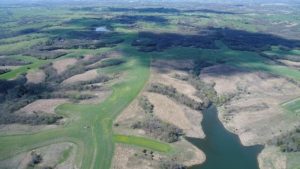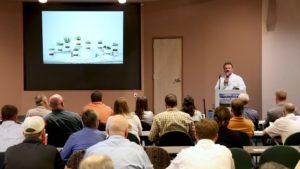Initial 200,000 Acre Grand River Project to Demonstrate Benefits for Environment, Wildlife, and Renewable Energy
Ultimate Goal: 30 Million Acres in 30 Years
St. Louis and Princeton, MO – An unprecedented gathering of business, agriculture, grazing, conservation and government change-agents helped launch a market-based approach to reduce soil erosion and nutrient run-off on endangered landscapes.

The Grand River Conference pilot project seeks to improve a watershed that contributes heavily to the expanding Gulf of Mexico ‘hypoxia zone’ and establish a model that can be implemented across the Mississippi River basin. The ultimate goal is to affect 30 million acres in 30 years.
Approximately 200,000 acres is being strategically selected to implement alternative land use practices that will improve the Grand. A video report summarizing the conference is available at https://roesleinalternativeenergy.com/grand-river-watershed/.
The new practices for the landscape involved in the project include:
- Convert highly erodible land to native prairie instead of row crops
- Institute cover crop programs on agricultural land
- Install riparian barriers at riverbanks
- Plant contour native grass buffer strips to absorb fertilizer, rainfall and soil runoff
 Participating landowners would receive payment for harvesting and selling native prairie and cover crop vegetation as biomass for renewable natural gas (RNG) production. Existing environmental incentive and conservation program funding would be utilized for additional financial incentive to participate.
Participating landowners would receive payment for harvesting and selling native prairie and cover crop vegetation as biomass for renewable natural gas (RNG) production. Existing environmental incentive and conservation program funding would be utilized for additional financial incentive to participate.
New Conservation/Energy Market: Cover Crops & Prairie Biomass for Renewable Natural Gas
The Grand River conference was organized by St. Louis-based Roeslein Alternative Energy (RAE) and hosted by Smithfield Foods at their regional office in Princeton, Missouri on May 17, 2018. RAE is in engaged in a large project to capture methane from hog manure at Smithfield’s nine northern Missouri farms and convert it to renewable natural gas using anaerobic digestion systems.
“Through this initiative, multiple partners are coming together to improve the local landscape and waterways,” said Rudi Roeslein, President and Founder of Roeslein Alternative Energy. “Together, we’re creating a pathway that works; a market-based solution around nutrient losses, water quality, and clean air.”
Promoting Native Plants and Soil Health Practices on a Watershed Scale in North Missouri
The Smithfield Foundation, Smithfield’s philanthropic arm, and the Environmental Defense Fund have already committed resources to convert 1,000 acres of highly erodible land to native prairie as part of the Grand River initiative.
“We don’t simply talk about sustainability. We are leading our industry in this area and partnering with other organizations to ensure long-lasting change,” said Stewart Leeth, vice president of regulatory affairs and chief sustainability officer. “We hope this project and our multi-organizational approach will serve as a model for other companies looking to tackle environmental challenges while creating value for their business and seizing opportunities to create a better planet for future generations.”
“No Bare Ground” and “Don’t Farm Naked” – Mantras from The Grand River Conference
The Grand River Conference included video from a RAE-funded helicopter tour of the upper Grand River, illustrating heavy erosion produced by row-crop farming on highly erodible land along with nutrient and sediment runoff from farm fields into watersheds. A facilitated discussion focused on opportunities and barriers to establishing the 200,000-acre pilot program followed a series of science-based presentations on land use practices including:
- Progress reports on native prairie restoration projects currently underway
- Presenters: David Wolf, The Environmental Defense Fund; Conner Woods and John Murphy, Roeslein Alternative Energy; Jordan Giese, Iowa State University
- “We are starting in the uplands by trying to affect the Highly Erodible Land in those portions of the watershed with productive prairie that meets all three objectives of the vision: Ecological services, wildlife habitat benefits and biomass yield for energy production,” Murphy said.
- Landscape-scale conservation approaches for the Grand River
- Presenters: Steve Harrington and James Cole, The Nature Conservancy
- “This part of the Mississippi River basin is going to be incredibly important as we try to answer questions about nutrient runoff and water quality,” Harrington said. “In-field, edge-of-field and downstream sources of nutrients are important areas where we can help innovate and align funding to help. All of this adds up and can make an impact.”
- Watershed hydrological modeling
- Presenter: Noel Aloysius, University of Missouri
- “The problems of sustainability are global, but the solutions are local,” Aloysius said. “The Grand River basin receives 40 inches of rainfall per year. About 30 percent of the rainfall is run-off and carries nutrients. The key question for the Mississippi River watershed is how much adoption is needed to achieve nutrient reduction goals.”
- Cover crop usage and economics
- Presenter: Sarah Carlson, Practical Farmers of Iowa
- “Make cover crops pay on your farm as an economic tool,” Carlson said. “How can we make it pay? Control cover crop seed costs by using inexpensive ones first, reduce herbicide cost since cover crops control weeds, avoid cover crop failure by ensuring herbicide programs match up, and avoid redundant expenses since no stabilizer may be needed when cover crops are in use.”
- Native mixes as alternative biofuels
- Presenter: Clarence Lehman, University of Minnesota
- “What land could be allocated for biofuel prairie biomass?”, Lehman said. “The best land in the country for this biofuel is in Northern Missouri.”
The Grand River Conference ignited a spark within the conservation community to drive action to preserve and restore landscape, with participants initiating action items that resulted from it. Announcements on progress toward assembling the 200,000 acres for the pilot program are forthcoming.

